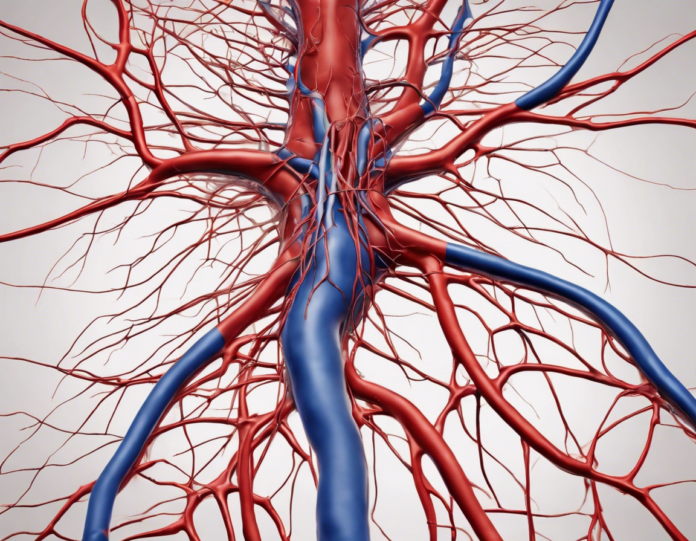The vascular system in the human body is a complex network of blood vessels that serves the vital function of delivering oxygen and nutrients to tissues while removing waste products. This intricate network consists of arteries, veins, and capillaries that are interconnected in a specific way to ensure proper circulation throughout the body. In this article, we will delve into the fascinating world of vascular interconnections in the human body, exploring the anatomy, physiology, and clinical significance of this essential system.
Anatomy of the Vascular System
Arteries
Arteries are blood vessels that carry oxygen-rich blood away from the heart to various parts of the body. The largest artery in the body is the aorta, which originates from the left ventricle of the heart. Arteries branch out into smaller vessels known as arterioles, which further divide into even smaller vessels called capillaries.
Veins
Veins are blood vessels that return oxygen-depleted blood back to the heart. The largest vein in the body is the inferior vena cava, which carries blood from the lower body to the heart. Veins merge into larger vessels known as venules, which eventually lead back to the heart.
Capillaries
Capillaries are tiny, thin-walled blood vessels where the exchange of oxygen, nutrients, and waste products takes place between the blood and tissues. Capillaries connect arterioles and venules, forming a microcirculation network throughout the body.
Interconnections in the Vascular System
Arteriovenous Anastomoses
Arteriovenous anastomoses are direct connections between arteries and veins that bypass the capillary bed. These interconnections play a crucial role in regulating blood flow and temperature in certain parts of the body, such as the skin and extremities.
Collateral Circulation
Collateral circulation refers to the alternative pathways that blood can take when the primary route is obstructed. These pathways are often dormant under normal circumstances but can become active in response to a blockage in a major blood vessel.
Portal Circulation
Portal circulation is a unique system where blood flows through two consecutive capillary networks before returning to the heart. The most well-known example of portal circulation is the hepatic portal system, which carries blood from the digestive organs to the liver before it enters the systemic circulation.
Physiological Significance
The interconnections in the vascular system serve several vital physiological functions in the body:
- Regulation of Blood Flow: Interconnected blood vessels allow for the precise regulation of blood flow to meet the metabolic demands of different tissues.
- Thermoregulation: Arteriovenous anastomoses help regulate body temperature by adjusting blood flow to the skin in response to external conditions.
- Wound Healing: Collateral circulation plays a crucial role in facilitating tissue repair and regeneration by providing alternative routes for blood flow in case of injury.
- Nutrient Exchange: Capillaries facilitate the exchange of oxygen, nutrients, and waste products between the blood and tissues, ensuring proper cellular function.
Clinical Relevance
Understanding the vascular interconnections in the human body is essential in the context of various medical conditions and interventions:
- Peripheral Arterial Disease: Collateral circulation becomes crucial in individuals with peripheral arterial disease, where blockages in arteries can lead to tissue ischemia.
- Stroke: In the case of a stroke, rapid restoration of blood flow through collateral vessels is essential to limit brain damage.
- Liver Disease: Disruption of portal circulation can occur in liver diseases, leading to complications such as portal hypertension.
- Surgical Interventions: Surgeons must consider the vascular interconnections when planning procedures to ensure adequate blood supply to tissues.
Frequently Asked Questions (FAQs)
1. Why is collateral circulation important?
Collateral circulation provides alternative pathways for blood flow, ensuring that tissues receive an adequate blood supply even in the presence of blockages in major blood vessels.
2. How do arteriovenous anastomoses help regulate body temperature?
Arteriovenous anastomoses in the skin allow for the shunting of blood flow to dissipate heat or conserve warmth, helping to regulate body temperature in response to environmental changes.
3. What is the significance of portal circulation in liver function?
The hepatic portal system allows for the detoxification and processing of nutrients from the digestive tract before the blood reaches the systemic circulation, playing a crucial role in liver function.
4. Can collateral circulation be enhanced or developed?
In some cases, such as chronic limb ischemia, collateral circulation can be stimulated through exercise or certain medications to improve blood flow to affected areas.
5. How do vascular interconnections impact surgical outcomes?
Surgeons must carefully consider the vascular anatomy and interconnections to avoid compromising blood flow during surgical procedures, which can affect tissue healing and overall patient outcomes.
In conclusion, the vascular interconnections in the human body form a sophisticated network that ensures proper blood flow and nutrient exchange to maintain tissue health and function. By understanding the anatomy, physiology, and clinical significance of these interconnections, healthcare professionals can better appreciate the complexity of the vascular system and its role in overall health and disease management.
